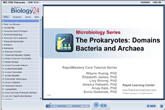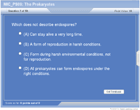| How to Learn in 24 Hours? |
|
| Need Help? |
M-F: 9am-5pm(PST):
Toll-Free: (877) RAPID-10
or 1-877-727-4310
24/7 Online Technical Support:
The Rapid Support Center
vip@rapidlearningcenter.com
Secure Online Order:

|
| Tell-A-Friend: |
Have friends taking science and math courses too? Tell them about our rapid learning system.
|
|
The Prokaryotes: Domains Bacteria and Archaea
| Topic Review on "Title": |
Three basic prokaryote shapes: cocci, spiral and bacilli.
- Cocci are roughly spherical to oval shaped.
- Bacilli are shaped like a prolate ellipsoid, but can appear filamentous or spindly.
- Spiral shaped prokaryotes.
- There are some variations of these shapes but these are predominant.
Cell arrangements:
- The final arrangement that the cells take depends on plane in which the cell divides. In binary fission the planes in which the cell divide determine arrangement.
- Diplococci are cocci pairs that remain attached create long chains called streptococci.
- Cocci that divide in two planes and stay attached form tetrads.
- Division in three planes form cuboidal packets called sarcinae.
- Clusters of cocci are called staphylococci and they resemble a bunches of grapes.
- Bacilli have less variability in arrangement because they divide perpendicular to the long axis.
- The diphtheriae bacteria divide by snapping and they form a V shape or side by side stacking called palisade.
- In hostile environments some bacteria can form Endospores. Endospores are not the same as reproductive spores.
Steps of endospore formation:
- DNA is replicated.
- DNA aligns with the long axis of the cell.
- The cytoplasmic membrane invaginates forming the forespore.
- The cell membrane continues to grow and the forespore is enveloped within a second membrane. The DNA of the vegetative cell disintegrates.
- A spore coat is formed around the endospore.
- The endospore matures by the completion of the spore coat.
- The endospore is released.
Extremophiles
- Microbes that need extreme conditions of: temperature, pH, salinity or atmosphere to survive.
DNA Facts
- The DNA of a cell is made up of guanine, cytosine, thymine and adenine. Guanine pairs with cytosine in DNA. The G+C ratio refers to the amount, in percent, of guanine and cytosine in a cells DNA. G+C ratio below 50% are considered log G+C bacteria. Above 50% G+C ratio is considered high. Gram-positive bacteria with low G+C ratios have similar 16s rRNA sequences and those with high G+C have rRNA sequences in common.
- Taxonomists have used the G+C ratio as a criteria for placing bacteria in phyla.
- Gram positive high G+C bacteria include bacteria that have rod shaped cells and filamentous bacteria. The latter look like fungi in how they grow and reproduce and sporulate.
|
| Rapid Study Kit for "Title": |
| Flash Movie |
Flash Game |
Flash Card |
| Core Concept Tutorial |
Problem Solving Drill |
Review Cheat Sheet |
 |
 |
 |
|
| "Title" Tutorial Summary : |
The Kingdom Prokayotes has within it the Domains: Archaea and Bacteria.
The domains are divided into phyla based on similarities in: morphology, reproduction arrangements of cells, endospore production, habitat, susceptibility to Gram stain, G+C content and rRNA sequences.
|
| Tutorial Features: |
Specific Tutorial Features:
- The Kingdom of prokaryotes is defined and the domains Archaea and Bacteria are described in taxonomic terms. The Extremeophiles which are microbes that exist at extreme conditions including high temperatures, extreme pH and salinity conditions, as well as those that live at high atmospheric pressures are examined.
- Reproductive strategies, microbe organization, cell structure of the prokaryotes are examined to elucidate how they are categorized and why they cultivate the niches they live in. Prokaryotes are a very diverse group of organisms that are believed to have evolved early.
Series Features:
- Concept map showing inter-connections of new concepts in this tutorial and those previously introduced.
- Definition slides introduce terms as they are needed.
- Visual representation of concepts
- Animated examples—of concepts are used to step wise breakdown a concepts.
- A concise summary is given at the conclusion of the tutorial.
|
| "Title" Topic List: |
Prokaryote shapes: cocci, spiral and bacilli.
Cell arrangements are effected by their initial shape and the plane in which they divide as in binary fission or if they divide by snapping. Also affected by weather they remain attached after replication.
Response to environmental changes: endospore formation.
|
See all 24 lessons in Anatomy and Physiology, including concept tutorials, problem drills and cheat sheets:
Teach Yourself Microbiology Visually in 24 Hours
|



